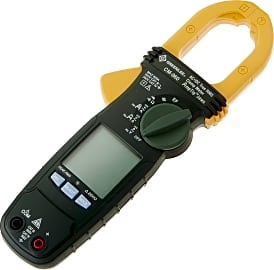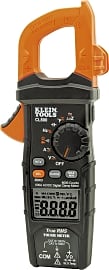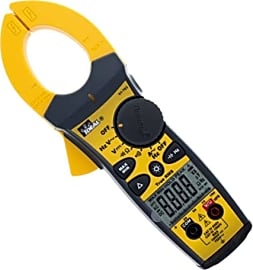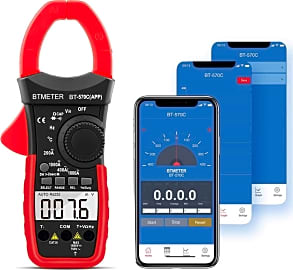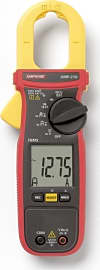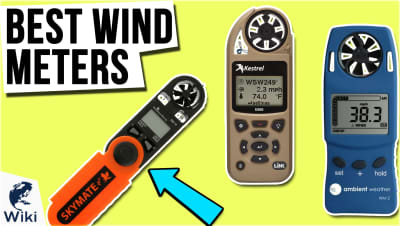The 10 Best Clamp Meters

This wiki has been updated 37 times since it was first published in October of 2015. Electrical contractors will want to check out these clamp meters, which make it easy to measure and identify any troublesome current fluctuations in household or commercial circuits. They are also good for the average DIYer diagnosing problems in their home or on a car or boat. We've included models with differing capabilities and at various price points to suit every need. When users buy our independently chosen editorial selections, we may earn commissions to help fund the Wiki.
Editor's Notes
August 27, 2020:
During this busy round of updates, while the Etekcity MSR-C600 was replaced by the Mestek CM81 — another budget pick with superior features, though a heavier price tag; the Fluke 322 was replaced by the Fluke 325 — a step-up model that includes a built-in capacitance meter and a superior ohmmeter; and the UEi Test Instruments DL369 was replaced by the UEi Test Instruments DL429B — a step-up model that boasts app connectivity, as well as the ability to measure inrush current and temperature.
In order to make room for some gear offered by top brand names that weren't yet featured on our list, we also decided to do away with the Meterk MK06, Mastech MS2115A and Signstek UT210E. Our new additions were the Greenlee CM-1560 — which is backed by a limited lifetime warranty and boasts a large, two-inch clamp size; the Ideal Industries 61-775 — which features a 1,000-amp maximum current rating and comes with alligator-clamp test leads; and the BTMeter BT-570CAPP — a surprisingly affordable model that boasts a 49-foot Bluetooth range and app connectivity.
A few things to think about for this category:
Overvoltage Categories: This is a very important consideration. So, for your safety’s sake — pay attention. All electrical metering equipment is awarded an overvoltage-category score between one to four (sometimes simply referred to as a safety score). You’ll often see this denoted using the industry-accepted shorthand “CAT I, CAT II, CAT III or CAT IV.” While it would be easy for me to recommend that everybody purchase a CAT IV tester, and be ready for anything, the cost difference between a CAT I and CAT IV unit can be massive and, depending on your intentions for the meter, an inexpensive CAT II model might be just fine for you.
A basic breakdown of the categories is as follows:
CAT I: This designation is given to testers that are strictly intended for metering protected electronic equipment, and are not suitable for working on any electrical systems. CAT I options were not deemed acceptable for the purposes of these rankings.
CAT II: This designation is given to testers that are intended for metering unprotected electrical equipment and single-phase branch circuits (under certain circumstances). This is a limiting designation, and one that we tried to avoid for the purposes of these rankings.
CAT III: This is likely the most common designation for multimeters, and one that leaves them fairly well equipped. Devices of this category are serviceable for some electrical contractors, and are suitable for three-phase distribution work, as well as everything downstream from there.
CAT IV: This category’s on the top of the pile, ready to go up against just about anything you throw at it, including “point of origin” metering, which happens upstream of your main overcurrent protection for any electrical system.
At times, meters will be given ratings in two safety classes, with a maximum voltage denoted for each class (the higher the class, the lower the voltage). For example, the Fluke 325 is rated to work on CAT-III installations up to 600 volts, but is also suitable to take on CAT-IV installations, just as long as they don’t exceed 300 volts.
Connectivity: This is a capability that most won't have much practical use for, but for the scholarly electrician who’s working on complex systems or chasing harmonic distortions, modern models in this category have begun to incorporate the ability to connect to smartphone applications, to better track and distribute data. Notably, this can also come in handy for regular, run-of-the-mill electricians who want to meter equipment remotely while they go to hook up/disconnect a conductor elsewhere on a job site.
We recommend the UEi Test Instruments DL429B for professionals looking for a unit that offers app connectivity. But, if budget’s an issue for you, you might also be interested in checking out the BTMeter BT-570CAPP, which is considerably more affordable.
Bells and Whistles: Most the units we’ve ranked share a basic set of capabilities, but there are many models that have one or more standout features, as well. While the Greenlee CM-1560 is the only unit we ranked that’s backed by a limited lifetime warranty, the UEi Test Instruments DL429B is the only piece of equipment that is capable of taking differential temperature readings, courtesy of its pair of K-type thermocouples. The Fluke 325 is available with a certificate from the National Institute of Standards and Technology, and the Ideal Industries 61-775 features a secondary screen on the bottom of the unit.
A note on safety:
Electrical work is dangerous at the best times and, even in the context of some small around-the-house jobs, it can cause fires that lead to serious injuries or even death. If you aren’t a qualified professional, for the sake of your and your family’s safety (as well as local bylaws, in some cases) ensure that any work done on your home or business is completed by a reputable, licensed electrician.
June 08, 2019:
We realize that not everybody has the same needs from a clamp meter. For example, a professional electrician may need the ability to test more electrical aspects, as well as a unit with a CAT IV rating, whereas the average consumer may only need to check a few things, like circuit load or continuity, and will generally not be testing very high-voltage systems, so a model with a CAT III rating will usually suffice. If you work in the electric industry and need to troubleshoot a wide variety of issues, then you will be best served by the Klein Tools CL800, Fluke 323, and Amprobe AMP-210. All three of these models are CAT IV rated and offer true RMS measurements, which means they will be accurate when used on pure and distorted waves.
All of the rest of the models on our list are rated CAT III or less, so they don't have the capacity nor insulation to make them safe for use on high-voltage systems, though they should be more than suitable for home DIY use. However, this is why you'll notice a large price discrepancy between the aforementioned models and the rest of the units on the list. The outliers here are the GTC CM100, which is a high-quality unit specifically designed for low-current applications where you need to identify parasitic draws that may not register on other meters, and the Milwaukee 2235-20, which is definitely a well-built unit that will last through years of constant use, but we feel is overpriced based on its capabilities.
While on the topic of price, the UEi Test Instruments DL369 is worth mentioning for the value it provides. It is a streamlined device that is easy to operate and has a very solid build that can stand up to getting knocked around in a tool bag, yet costs less than most other commercial-quality options.
AC Clamp Meters Versus DC Clamp Meters
A transformer inside of the AC clamp meter can detect and measure the magnetic fluctuations and convert those measurements into a current reading.
Clamp meters are available in both AC and DC models. A standard clamp meter used to measure AC currents cannot be used to measure DC currents and vice versa. This is because AC and DC currents have different properties. In an AC current, the flow of electricity periodically reverses direction causing a dynamically changing magnetic field. A DC current continuously flows in one direction and has a fixed magnetic field.
AC clamp meters are designed to detect the dynamically changing magnetic field produced when electricity flows through a wire. The fluctuations in the magnetic field caused by the AC current switching directions is directly proportional to the size of the current flow. A transformer inside of the AC clamp meter can detect and measure the magnetic fluctuations and convert those measurements into a current reading.
DC clamp meters makes use of a Hall Effect sensor to measure currents. The Hall Effect principal states that when a current carrying conductor is placed in a perpendicular magnetic field, the magnetic field will exert a transverse force on the charge carrier, which is perpendicular to both the current and the magnetic field. A small voltage runs across the Hall element when it is subjected to this transverse force, which is then amplified and measured to produce a current reading.
How To Use A Clamp Meter
Using a clamp meter is a relatively simple endeavor that does not require you to break a circuit or make a direct connection to any live wires. This makes it the ideal tool for the home DIYer who is still learning how to work with electrical components.
A reading should appear on the meter's display screen within seconds.
Your first step is to choose the electrical conductor you will be testing. It must be a live wire that is currently under load. If using it on an appliance, this means the appliance should be in operation during testing. If you have purchased a clamp meter which does not have autoranging, you will then need to select the correct measurement function and range. If unsure of the voltage range, it is always best to select a higher range and then decrease as needed.
Next, clamp the jaws of the meter around the conductor you are measuring. The jaws of the device should not be touching the conductor on any of its sides. If there are a number of other wires jumbled around the conductor you are measuring, you will need to untangle them so your clamp meter is only encircling the conductor to be measured. A reading should appear on the meter's display screen within seconds.
What To Consider When Buying A Clamp Meter
Not all clamp meters are created equal and it is important to purchase a quality clamp meter that will provide accurate results in the types of environments where you will be working. One of the first and foremost considerations must be accuracy of the readings. Ideally you should purchase a clamp meters that reports true-rms readings. If not, extraneous electrical noise from light bulbs and other devices in the room can cause inaccurate readings. In addition to offering a true-rms reading, your clamp meter should meet the industry accuracy standard of 2% ± 5 counts. Steer clear of any accuracy ratings stated to ± 10 counts.
Nearly every clamp meter can perform admirably in a clean and controlled lab setting, but more than likely you won't be working in this type of environment.
Nearly every clamp meter can perform admirably in a clean and controlled lab setting, but more than likely you won't be working in this type of environment. Look for a clamp meter that is designed to work in the kinds of conditions you will be subjecting it to. Some may be specified for indoor use only with minimum and maximum operating temperatures. If you use a clamp meter under or over its specified operating temperatures, your readings will be inaccurate.
Finally, you will want to look at the features of each clamp meter you are considering. It may seem like a no-brainer to go with one that offers the most additional features, but bear in mind that the more gadgets integrated into a clamp meter, the harder it may be to use for its intended application. Avoid clamp meters that have silly features like a tape measure. Instead, focus on purchasing one with the measurement functions you need to get the job done quickly and correctly.
Some useful features to keep an eye out for include Inrush measurement capabilities, which can be invaluable if you will be working on motors, autoranging, and a large blacklit display screen with a wide viewing angle.


